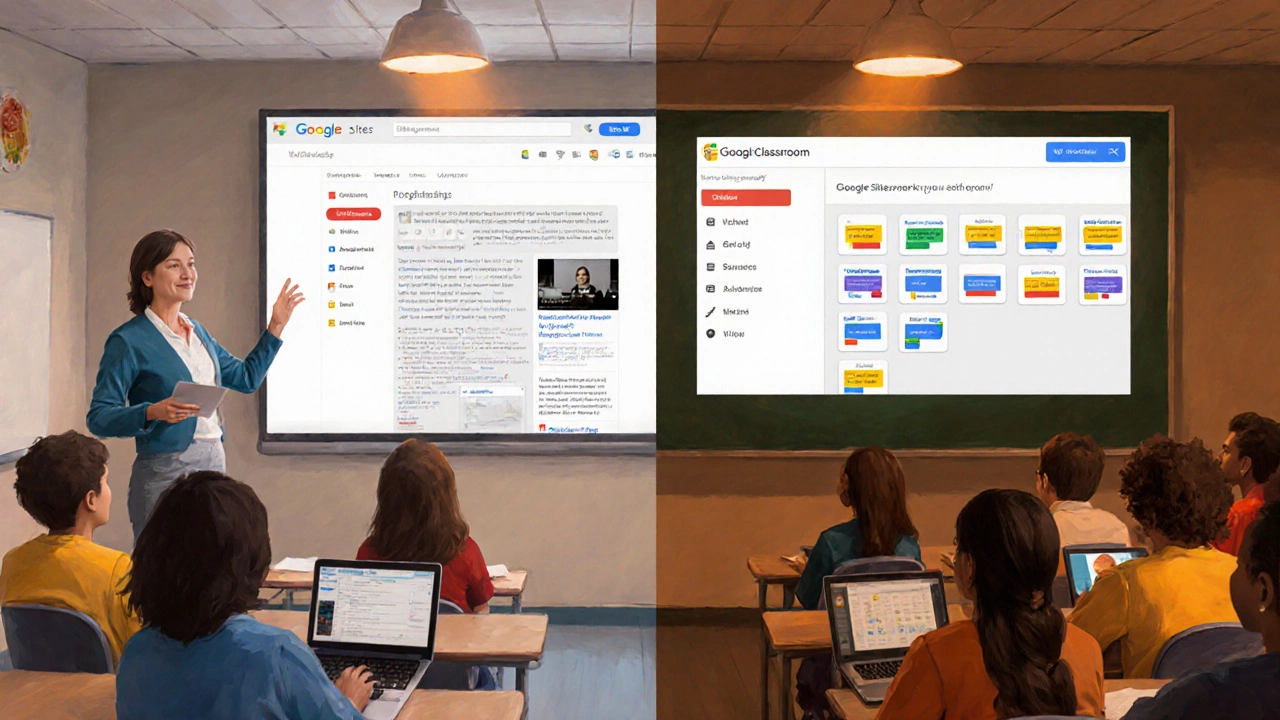Oct
12

- by Dhruv Ainsley
- 0 Comments
Google Course Builder Selection Tool
Which Google Tool is Best for Your Course?
Answer a few questions to find the most suitable Google tool for your course creation needs.
Select your requirements and click 'Find My Recommendation' to see which Google tool fits your needs best.
Ever wondered whether Google offers a dedicated tool for building full‑blown online courses? The short answer is yes - Google released an open‑source project called Google Course Builder, a platform that lets educators design, host, and deliver MOOCs (Massive Open Online Courses) without needing a separate LMS. But the story doesn’t stop there. Google’s ecosystem also includes Google Classroom, a class‑management hub, and Google Sites, a simple website builder that many teachers repurpose for course pages.
Key Takeaways
- Google Course Builder is an open‑source, self‑hosted solution launched in 2013.
- It integrates with Google Workspace (Drive, Docs, YouTube) for content storage and streaming.
- For quick courses, Google Classroom + Google Sites is often enough.
- Google’s tools are free, but you must handle hosting and technical setup yourself.
- Alternatives like Moodle, Canvas, Coursera, and Udemy offer managed hosting and richer features.
What Is Google Course Builder?
Google Course Builder is a free, open‑source framework written in Python that runs on the Google App Engine. It was created to let universities and NGOs produce MOOCs that scale to thousands of learners. The platform provides a modular course structure (units, lessons, assessments), built‑in analytics, and a simple UI for uploading videos, PDFs, and quizzes.
Because it’s open source, you can download the code from GitHub, customize the look and feel, and deploy it on your own Google Cloud project. The last official update came in 2020, but the community still maintains forks for newer App Engine runtimes.
How Google Course Builder Fits Inside Google for Education
The broader Google Workspace (formerly G Suite) supplies the storage, collaboration, and video‑hosting back‑ends that Course Builder leans on:
- Google Drive stores PDFs, slide decks, and supplemental files.
- YouTube streams lecture videos securely (unlisted or private modes).
- Google Docs and Google Slides let instructors co‑author materials in real time.
When you pair the core Course Builder engine with these services, you get a lightweight learning management system that’s fully under your control.
Step‑by‑Step: Setting Up a Simple Course with Google Course Builder
- Create a Google Cloud project. Go to the Google Cloud Console, enable the App Engine API, and choose a region.
- Clone the repository. Run
git clone https://github.com/google/coursebuilder.giton your local machine. - Install dependencies. The project uses
pip install -r requirements.txtand Python 3.9. - Configure settings. Edit
app.yamlto point to your Google Cloud Storage bucket for media files. - Deploy. Use
gcloud app deploy. After a few minutes your site will be live athttps://YOUR_PROJECT_ID.appspot.com. - Build the course. Log in with a Google account, click “New Course”, add units, upload videos to YouTube (set to unlisted), attach PDFs from Drive, and write quiz questions.
- Publish and monitor. Turn the course public or restrict access with email domains. Use the built‑in analytics dashboard to see enrollment numbers and completion rates.
If the command line feels intimidating, you can skip the self‑hosted route altogether and use the more user‑friendly combo of Google Classroom + Google Sites. That method requires zero code and still lets you embed YouTube videos, link Drive resources, and track student progress via the Classroom gradebook.
Google Classroom vs. Google Course Builder vs. Google Sites
| Feature | Google Course Builder | Google Classroom | Google Sites |
|---|---|---|---|
| Hosting | Self‑hosted on App Engine (requires Cloud billing) | Managed, free for Education accounts | Managed, free for Education accounts |
| Course Structure | Units, lessons, quizzes, analytics built‑in | Assignments, topics, gradebook only | Static pages; you build structure manually |
| Video Support | YouTube integration, private streaming | YouTube links or Drive attachments | Embed YouTube or Drive videos |
| Scalability | Designed for thousands of learners per course | Works for class‑size up to several thousand | Limited by site page count; not ideal for massive enrollments |
| Technical Skill Needed | Intermediate (cloud console, Python) | Basic (Google account login) | Basic (drag‑and‑drop site builder) |
| Cost | App Engine free tier covers small traffic; otherwise pay‑as‑you‑go | Free with Google Workspace for Education | Free with Google Workspace for Education |
When to Pick Google Course Builder
If you’re running a university‑scale open course, need custom analytics, or want to brand the learning environment beyond the Classroom UI, the self‑hosted builder is the right fit. Its open‑source nature also lets developers add new activity types (e.g., peer‑review, gamified badges) without waiting for Google to roll out updates.
However, for most K‑12 teachers or small training teams, the combination of Google Classroom + Google Sites is faster and less costly. You get a ready‑made gradebook, easy student invitations, and automatic syncing with Google Calendar.

Alternatives Worth Checking Out
If Google’s offerings feel too DIY, here are a few platforms that provide managed hosting and richer interaction tools:
- Moodle - open‑source LMS with extensive plugins, but you need to host it yourself or pay a MoodlePartner.
- Canvas - cloud‑based, strong multimedia support, free for institutions.
- Coursera - marketplace for MOOCs, handles payment, certificates, and global reach.
- Udemy - easy course creation, built‑in marketplace, revenue sharing model.
- Open edX - powerful open‑source platform used by MIT and Harvard; requires significant server resources.
Each alternative trades off control versus convenience. If you need a fully branded, data‑rich experience and have a dev team, stick with Google Course Builder. If you want plug‑and‑play and don’t mind platform fees, explore the options above.
Common Pitfalls and How to Avoid Them
- Ignoring hosting costs. Even the free tier can run out of CPU hours once you attract a few thousand learners. Set up budget alerts in Google Cloud.
- Skipping SSL. The App Engine provides HTTPS by default, but if you use a custom domain you must configure SSL certificates.
- Overcomplicating the UI. Keep the course navigation simple - too many custom widgets can confuse learners.
- Not leveraging Google Analytics. Attach a GA tag to the site to track drop‑off points in your lessons.
- Relying solely on YouTube public videos. Use unlisted or private videos for paid or internal courses to protect content.
Frequently Asked Questions
Is Google Course Builder still supported by Google?
The core project received its last official release in 2020, but the code remains open source on GitHub. Community forks keep it compatible with newer App Engine runtimes, and Google still hosts the documentation archive.
Do I need a paid Google Cloud account to run a course?
You can start with the free tier, which includes enough instance hours for a modest pilot. If traffic spikes, Google Cloud will bill you based on usage, so set budget alerts.
Can I integrate Google Meet for live sessions?
Yes. Simply embed a Meet link in a lesson page or schedule a live event through the Google Calendar integration that Course Builder supports.
How does Google Course Builder handle assessments?
It provides built‑in multiple‑choice and short‑answer question types, automatic grading, and a progress dashboard. For advanced assessments you can add custom Python scripts.
Is there a way to issue certificates?
The platform includes a simple certificate generator that pulls the learner’s name from their Google account and creates a PDF you can email after completion.
Next Steps for Different Scenarios
For solo educators who just need a quick way to share videos and PDFs, create a Google Site, embed YouTube lessons, and invite students via Google Classroom. You’ll be up and running in under an hour.
For institutions planning a full MOOC, clone the Course Builder repository, set up a dedicated Google Cloud project, and customize the UI to match your brand. Allocate a small budget for hosting and SSL, then pilot with a single course before scaling.
If you need more features out of the box, evaluate Moodle or Canvas. Both support LTI integrations, which means you could still embed Google Drive content while getting richer grading tools.
Whatever path you choose, the key is to start small, gather learner feedback, and iterate. Google’s tools are flexible enough to grow with you, whether you’re teaching a handful of students or thousands worldwide.





